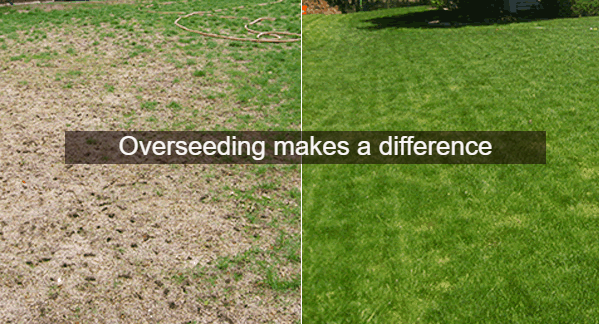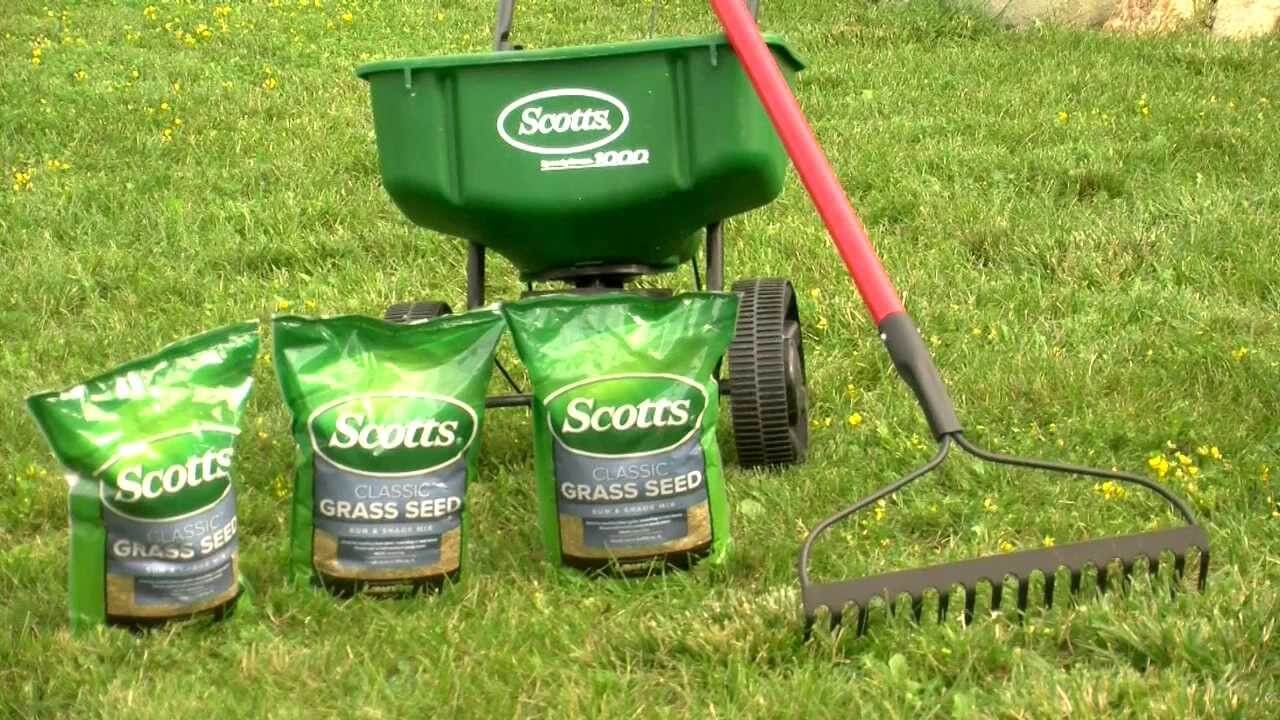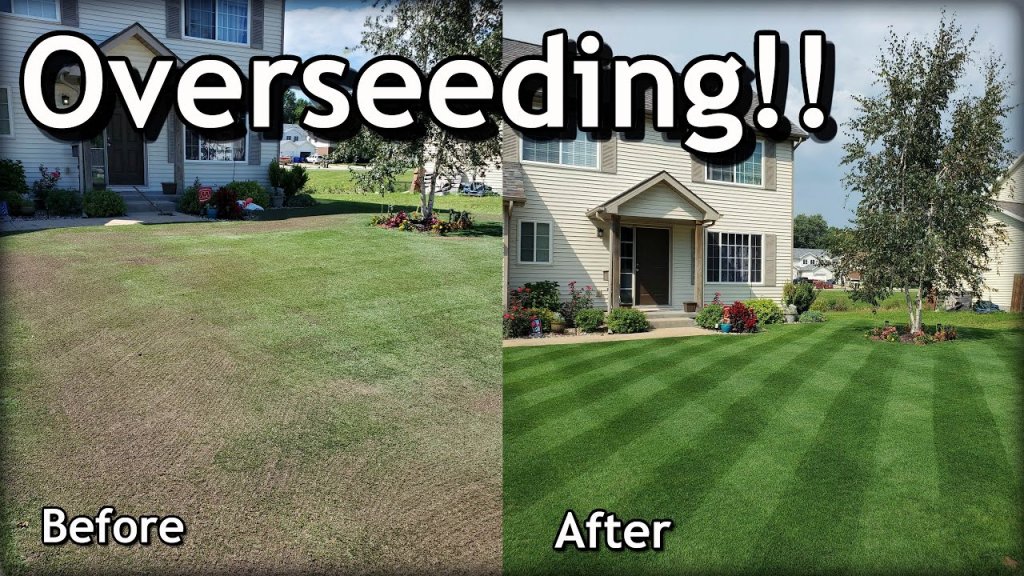Do you want to have a beautiful lawn that has fresh grass? But are you worried about the bare spots and thinning grass? This can happen even after taking care of your lawn and giving it all the other nourishment and other maintenance. If you are looking to know how to overseed a lawn, then you are at the right place.
With time grass in your lawn withers and dries. It stops looking as green as it should be. If you want a large garden with healthy grass, you must understand that not all grass varieties are suitable for all places. You must know the type of grass right for your topography, and you must also use the correct technique of planting that grass. For getting good green grass, you must use the method of overseeding.
Overseeding is the way of adding grass seeds to your lawn without digging the soil. This helps in building a great depth and gives a thicker grass with a lush look. Thus, overseeding is the way of correcting the thinning turf of your lawn by adding extra seeds.
What Should you Know before Overseeding?

Overseeding helps to give the turf a great depth and density and enhance the color and add several grass species. However, it is a long and tiring task. And there are several things you must know before proceeding with the grass seed addition.
For several reasons, you must understand that your turf will deteriorate, and overseeding with grass seed mixture and adding other grass varieties will help in getting the green look. This involves sprinkling seeds on all the bald spots and highlighting the areas that were not seen before on the turf.
Before beginning to proceed, the things you must know are the soil condition, the drainage condition, the water availability, fertility of the soil air circulation, sunlight, the grass variety being grown, and the care that is being provided. Usually, one of the following factors is missing or not taken care of appropriately, and that is why your lawn will need overseeding.
Why Should you Overseed a Lawn?
There are several reasons why you should consider overseeding your lawn. If you are house in an area that frequently faces drought, famine, and extreme temperatures, your lawn grass can deteriorate over time. Overseeding your lawn will help in giving it a plusher look and greener vibe.
A healthy lawn is desirable and a good sign of a house. Overseeding improves appearance, health and adds variety to your lawn. It also gives you a way of adding resistant types of grass to the lawn to last longer, and the turf looks beautiful.
How to Overseed a Lawn?

Here are the steps you need to follow to overseed your lawn.
Step 1. Preparing the lawn
There are several ways of seeding a lawn, but all the basic steps required are the prep stage. For the prep stage, you must ensure aeration and ensure that all the seeds to be overseeding have good contact with the soil.
You need to do a thorough analysis of your lawn and find out if there is a thatch present. If it is there, you need to give good air circulation to the yard before it is overseeded, for this will need to mow all the grass and remove the dried out dead grass spread in all the areas of your lawn. Now you will need first to cut all the grass short and trim with a mower.
This should be done with the lowest setting on the mower. You will need to bring the grass to a mowing height and then bag the grass’s clipping that you have cut. After this is done remove all the debris and unwanted grass from your lawn so that the topsoil layers are loosened.
This method also involves improving the condition of your soil. Thus, it is essential to get good germination and its soil so that the seed settles in faster and grows at a much faster rate. For this, you will need to use fertilized soil or use a good mower so that a good soil layer can be obtained. This should be done so that existing grass is not killed, but conducive conditions are created for new grass to grow.
Step 2. Seeding
The next step is to choose the correct seeds based on topography, climatic conditions, water availability, and soil availability. You must also consider your lawn condition and if it has fertilized soil suitable for a particular variety. You will need to start the procedure and ensure that the seeds are spread evenly throughout your lawn.
No products found.
No products found.
If the soil is significantly impacted and torn, you must provide enough air circulation there. Remember all the procedure needs to be done so that the seed is caught in the holes and gives good germination.
Step 3. Care and Maintenance
The last step for overseeding your lawn is taking care and maintenance. Watering your lawn is very important for success for overseeding. You will need to water the seeds immediately after you pour them. It would help if you continued every day until your seeds germinate. This procedure can take up to 15 days.
It will help if you remember proper care and maintenance is essential for giving your lawn a good look. The first water should be heavy, and one inch of water should be given, you can. Then lighter watering can be given after grass is germinated. After the grass starts germinating to the height of the previously existing grass, water should be provided based on its requirement.
What are the Essential Tools Used for Overseeding?
There are several essential tools you must have for overseeding your lawn. It would help if you had a lawnmower, a reck, and a seeder. These are all necessary to give your lawn a successful overseeding makeover and carrying out the work in a hassle-free way. Usually, all these two tools are readily available by homeowners, and if you do not have one, you can always contact professional services.
What are Different Overseeding Methods?
There are several overseeding methods, and you need to find out a suitable way for your lawn. The technique should deliver the results you are aspiring for and help give your grass a greener and healthier look.
Seed Silting Mechanical Silt Seeder
You will need an established lawn with bald spots and thinning grass to use a mechanical silt seeder in this method. It helps in cutting through the thatch layer and opens cavities in the soil. The depth of this thread is usually based on the grass use and the soil’s current condition.
It is always important to remember that you must not go deeper than half the length of your grass seed. You must ensure proper silt seeding is carried out. It would help if you also remembered that the tool you are using should have concave disc blades following in the silts’ direction.
It helps in keeping the cavity open when your seed is dropped. It also ensures that the seed gets in the soil, where it can essentially germinate. Overseeding also takes fewer seeds. There are higher chances of the seats penetrating the soil and growing faster.
Usually, two rounds of using a mechanical server are enough for getting healthy soil and excellent germination. Cross-thatching at a 45-degree angle has been proven successful for many people, and it seems their lawn is getting healthier. This is how to overseed a lawn correctly.
Broadcast Seed Method
Another method of overseeding that is quite popular is the broadcast seed method with a cyclone seeder. This method is also quite effective, but it does not use a mechanical seeder. In this, you will first need to aerate your soil several times before the seeds are broadcasted into the soil.
The aeration holes should help in catching these dispersed seeds and capture them. It also helps to better penetrate the seeds in the soil plants and gives an excellent seed to soil contact. This method requires higher maintenance because heavy watering and trimming are essential to this method.
There are several things you need to take care of that are proper watering, aeration and light, and enough soaking time. Usually, when using the broadcast seed method several times, the seed gets hung up in the thatch layer and does not reach the soil where it can germinate.
You must do it so that the creeping method is utilized and take a lumpy or spotted look on your soil is not seen. The broadcast seeding method does not have an excellent germination rate as the silt feeder. This method is a great option when you have a smaller lawn.
What is the Best Time to Overseed?

Overseeding often requires a lot of planning, and if you want a good green lawn, you must consider the season and time when you are planning to do it. Usually, the best time is in the fall when the soil is warm and the temperature is more relaxed. This time also ensures that there are fewer weeds in the new grass. There is also plenty of sunlight available, and germination is carried out successfully. At this time, you can also use the springtime to overseed your lawn. Late spring has a warmer soil temperature which is essential for all your grass to germinate.
Overseeding is an inexpensive way to revive your lawn, and proper planning of time and when to plant your seeds can help you get back a beautiful lawn that will impress everyone.
Benefits of Overseeding
Now that you know how to overseed your lawn, there are a few things you must know before you consider overseeding. These things are the benefits of overseeding your lawn and why it is an investment you should make. Weather variation and weeds can often take a toll on your property and cause thinning of green grass.
Overseeding is an inexpensive way to get an excellent healthy and long grass back. It can take a lot of time and effort to create a new lawn grass again. When done correctly at the right temperature and using the correct seeds and watering pattern, your lawn can look beautiful.
Prevents Soil Erosion
Overseeding also helps in preventing and reducing soil erosion. Since grasses have a fibrous root system, they hold the whole soil together much better than plants. When they are densely planted with overseeded grass, the water stays there, and the runoff and soil loss in this area is less. This is essential to sustain the overall ecosystem of your lawn, and the nutrients and moisture will always be in that because the roots of these overseed grass hold it together well.
It Gives A Beautiful Appearance
Another reason you should oversee your grass is that it improves your grass’s overall appearance and gives it a luscious look. With time, balding patches appear on your lawn, and several pests and pets damage it. Overseeding helps provide healthy soil that is inviting, pleasing to the eye, and you will feel wonderful walking on your lawn. It will also be a favorite among children and visitors.
It Helps in Giving Thicker Grass
Overseeding your lawn also helps give a thicker grass, and once the season passes, you will get a plush stretch of green grass. These all form a beautiful surface, and they are durable and even much more resistant to natural weathering and environmental stress.
Inexpensive
Another reason why overseeding your lawn is a great choice is that it helps in giving a healthy, robust lawn without spending much. Overseeding is relatively inexpensive, and you do not need any expensive fertilizers and tools to correct your lawn’s problem. Correct watering and overseeding from time to time can give you a beautiful view without spending a lot on creating a new grass patch.
Conclusion
If you wish to have a beautiful lawn and enjoy the flowing grass beneath your feet, overseeding is your way to go. It is easy, inexpensive, and very beneficial for your soil ecosystem and for all the grass that thrives on your lawn. Now that you have learned how to overseed your lawn do it today and see how it can transform your lawn looks.

